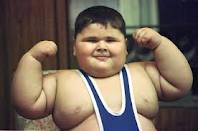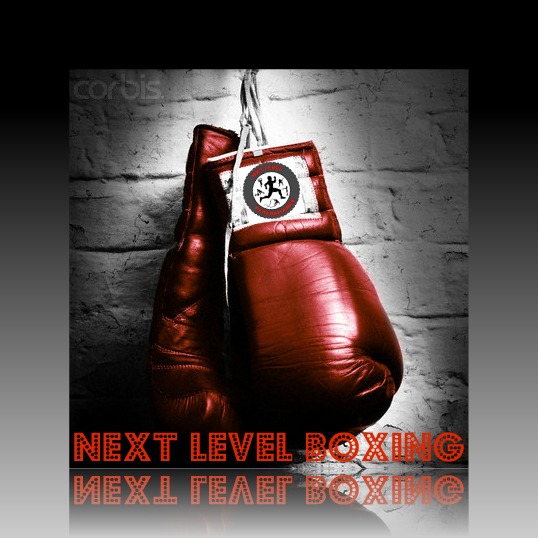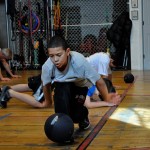ROD 022812
ROD
Tuesday, 28Feb12
Ready for Anything Training!!!!!
This Super Boxing X-Treme class is a 1 hour ass kicking circuit that will leave you in a puddle of sweat.
Your cardiorespiratory and muscle strength will benefit from our motivational, challenging and fun circuit training set to energetic music.
Let’s see what you’ve got!!!!
____________________________________________________________
This class is built for speed, agility and strength. This class is not for convenience, nor is it for those who want to use light weights. This class is for those who are looking to take their fitness to the next level. The movements expected in this class are advanced. Every participant will be expected to perform the suggested lb’s for each movement and post their time or rounds completed when applicable to comments. Those of you who do not want to meet these requirements are invited to the Boxing class. We have members who want to go outside their comfort zone and take their fitness to another level.
Ladder This For Time
- DB Thrusters (w 20lb or > / m 30lb or >)
- Clapping Push-ups
- Box Jumps
- Kettlebell swings (w 20kg or > / m 24kg or >)
Post times to comments…..
_________________________________________________________
How Should Children Exercise?
People often ask questions about children exercising. And you might find this surprising, but the plurality of kid-related questions I receive pertain to exercise. Not food – So I’ll go through two of the most common queries, paraphrased, and answer them, then follow up with my recommendations for ideal – but totally achievable and realistic – kid fitness.
But first, let’s go over the dire situation we currently face. Kids are not very active. They are fatter, more sedentary, and more unhealthy than the previous generation of kids.  Whereas in 1969 42% of American children walked or biked to school, just 16% did so in 2001 (and I imagine the number has decreased since then). This isn’t me crowing about the good old days of kids walking uphill backward and barefoot in freezing snow to school while the blazing hot sun paradoxically burns overhead and having to stop along the way to haul hay bales and fistfight bullies all while doing arithmetic without calculators and researching term papers without the Internet (although let’s face it – those were good times). These are incontrovertible facts, confirmed via empirical evidence and by counting the number of kids you see with noses buried in iPads. Preschoolers are sedentary (even during outdoor playtime), children from low socio-economic households are sedentary (PDF), teens are sedentary, and don’t get me started on those lazy infants.
Whereas in 1969 42% of American children walked or biked to school, just 16% did so in 2001 (and I imagine the number has decreased since then). This isn’t me crowing about the good old days of kids walking uphill backward and barefoot in freezing snow to school while the blazing hot sun paradoxically burns overhead and having to stop along the way to haul hay bales and fistfight bullies all while doing arithmetic without calculators and researching term papers without the Internet (although let’s face it – those were good times). These are incontrovertible facts, confirmed via empirical evidence and by counting the number of kids you see with noses buried in iPads. Preschoolers are sedentary (even during outdoor playtime), children from low socio-economic households are sedentary (PDF), teens are sedentary, and don’t get me started on those lazy infants.
And the evidence is pretty clear that active kids and teens become active adults, while sedentary kids and teens become sedentary adults. If that’s true, the next generation of adults is going to be more sedentary than the current group unless you guys – the parents – do something about it. Notice that I said nothing about the government stepping in. They can make recommendations (the same ones they’ve been making for decades to little effect), but it comes down to you. Are you going to start walking and exercising and playing so that your kid follows your example and maintains interest in movement from an early age? Because that’s what it’s going to come down to. It’s not even a big deal. Kids love to move. They are born with the desire and innate drive to move throughout the world, climbing and lifting and throwing things. We stifle that with our chairs and school schedules and passive modes of entertainment, but the drive to move is there. This isn’t an obese diabetic with bad knees you’re trying to motivate. This is a kid brimming with kinetic energy who will engage in intense activity, given the chance. Take advantage of that and give it!
Okay, now that the ugly stats are out of the way, let’s get to the meat.
Does lifting weights stunt growth?
Everyone’s heard that kids who lift weights will suffer stunted growth. When Carrie and I were having kids, it was even the official recommendation of the American Academy of Pediatrics that children not be allowed to strength train, with the justification being it would damage growth plates and retard bone growth (and thus height). Before we examine the evidence, let’s talk about growth plates. What are they, exactly?
At either end of “long bones” (bones that are longer than they are wide) are epiphyseal plates, also known as growth plates. A bone grows at the ends and as it does, the growth plates are constantly in flux. The chondrocytes are always dividing to produce more and newer bone, and this renders the “energy-absorbing capability” of the growth plate “lower than that of bone, ligament, or tendon.” In growing kids, the growth plates are more susceptible to injury than ankles or other common areas of injury because they will “fail first.” About 85% of people with growth plate injuries enjoy normal, uninterrupted growth, but the potential for interrupted growth nonetheless exists.
That being said, no research has ever shown that weight training actually stunts growth in youth. In fact, just like adults who lift, kids who lift enjoy stronger bones (which extends into adulthood), increased lean mass, improved insulin sensitivity, and overall better health. A recent review (PDF) of all the epiphyseal injury literature found that the bulk of epiphyseal injuries occur on the football field, and that of the injuries attributed to weight training, 7.4% were epiphyseal. Of “all sports,” 10% of injuries were epiphyseal. The takeaway from the review is that growth plate injuries can occur in any sport, not just weight training (and even there, it’s not as heavily represented).
So, you see, the answer isn’t as simple as “yes” or “no.” Weight training with excessive loads, improper technique, and/or poor programming can lead to epiphyseal growth plate injuries, just as they can and do lead to general injuries in weight lifting adults, but so can football hits, snowboarding accidents, and bike mishaps. Injury can happen anywhere and in any activity. I’d even argue that because strength training takes place in a controlled environment – no bodies flying at you from across a field, no split-second decisions, no quick movements in either direction, just you and the weight – it is safer than many other forms of childhood physical activity. The evidence (what little there is) seems to support this contention.
If your child is going to lift weights, get the kid’s form dialed in and checked by an expert. Have him or her lift for higher reps and lower weights; no heavy singles or five rep maxes until later adolescence, when the growth plates have closed. Lift with your child, and don’t let them lift alone. If enthusiasm gets the better of them and they try to go for a max and you’re not there to supervise, bad things could happen.
Can kids benefit from regimented programs like NLP?
Potentially. Fitness programs are only necessary because physical activity is no longer required for survival. I have to make the decision to go for a walk or a hike because I no longer have to walk to get food or water. I lift heavy things in the gym because I no longer have to do manual labor or hunt animals to live. All exercise programs are replacements for once-compulsory activity that’s no longer compulsory. Of course, I’d argue that activity is compulsory, but not in the sense that most people mean it. Being a couch potato won’t kill you today. It’ll kill you down the line.
However, if your kid is naturally active, a highly regimented program isn’t really necessary. Strict programs will help kids who have “forgotten” how to play and move around.
PBF’s movements are perfect for younger kids because they focus on manipulation of their own bodyweight. Even the most strident naysayer of youth weight lifting would admit that kids are equipped to safely move their own bodyweight.
My “Guidelines” and Recommendations
Here’s what I’d do if I had to raise a kid all over again and I wanted them to become a healthy, active, strong human. These are my soft guidelines and recommendations.
Provide Ad Libitum Play
Play must be the foundation. Play is fun, and the way kids play is usually active. You let kids play, then, and they’ll do so by moving their bodies and exploring the world, and this will create a powerfully positive association with movement and physical activity. Then, if you want to introduce something more regimented later on, they’ll be more open to it. But play must always form the basis of children’s movement.
Many adults can get away with grueling workouts as the basis of their leisure time (not me), but kids cannot.
Focus on Form and Technique
Untouched, unmarred kids will generally show pretty good – maybe flawless – form when squatting and lifting things. They’re bendy and flexible and mobile and their connective tissue hasn’t hardened or stiffened up from misuse or disuse. Thus, if you can instill excellent form and make sure they maintain that form from an early age, they’ll be set for life.
Most exercise injuries come from bad form and technique. If you want to avoid those dreaded growth plate injuries, whether your kids are weight lifting, doing plyometrics, running, playing sports, or just playing, focusing on form is essential.
Keep “Workouts” Short and Snappy
Don’t linger too much on one exercise. Instead of putting your six year old on Starting Strength for toddlers, work the movements into everyday life so your kid gets short bursts of activity. Bust out with squats in the middle of a walk to school. Do some Grok crawls down the produce aisle. Sprint to the stop sign. Pick up every rock you find on your hike, making sure your kid displays a proper hip hinge every time (this is a good way to cement excellent form for both parent and child).
When you do a workout, keep things moving. Don’t prescribe specific reps and sets every single time you exercise.
“Disguise” Your Workouts
Instead of five founds of Grok crawls, box jumps, and pullups, set up an obstacle course in the front yard or at the park. Tunnels that you have to crawl through, cones that you have to jump over, and a tree that must be climbed. Let kids be kids and keep things fun.
Push sports, but don’t put too much pressure on your kid, especially by focusing obsessively on one sport or activity to the detriment of overall general development.
Pressure breeds resentment and kills enjoyment. While an adult weight lifter going for a max deadlift probably benefits from his workout partner (read: peer) screaming in his ear to “Pull!”, a ten year-old kid isn’t going to get better at free throws because his dad (read: parent, authority figure) screamed at him to do so. You’re trying to organically foster enthusiasm for movement, sport, and fitness, and you do that by letting the kid discover his own path and being there to nudge him in the right direction when asked.
Get baseballs, soccer balls, footballs, and basketballs. Your kid should play the sport your kid wants to play, not the one you wished you could play.
Participate!
You’re not a coach. You’re the parent. Join in with your kid. Use him or her as a weight. Wrestle with them. Go outside with them. Race them. Climb trees with them. I see parents at playgrounds staring at their phone while kids play, often alone, and I shake my head at the missed opportunity. Get in there and play too!
Buy a small kettlebell for your kid. Make some sandbags, clubbells, and slosh tubes in adult and kid sizes.
Let Them Climb Stuff
Trees, pullup bars, ropes, fences. If you can, see about installing a pullup bar or rope climb at your place of residence. Have that kid climb on that thing as much as possible as soon as those opposable thumbs are functioning.
Let Them Jump Onto and Off of Stuff
Kids fall, a lot. Teaching them how to launch themselves into the air and handle themselves while there will help avoid many of the potential downsides of the inevitable descent. It may even lower the incidence rate of accidental falls, and it will certainly improve their ground-foot interfacing skills.
Let Them Balance on Stuff
Balance is an essential skill that will pay dividends down the line, in both everyday life and athletic endeavors. Simple planks of wood laid out in the yard make for a safe, effective balance beam. This will also make expert maneuvering of the cracks in the sidewalk (and avoidance of maternal lumbar fractures) possible.
Let Them Swim
Swimming is a valuable skill that will stay with your child for life. It’s like flying. At least, that’s how I saw it when I was a kid.
Relax!
Kids do dangerous things as a rule. They ride skateboards and make jumps. They climb trees and fall from them – sometimes on purpose to “see what happens.” They play football, get in scuffles, and make hairpin turns at breakneck speeds while dribbling a ball (with either hands or feet). Sports are dangerous, sure, but so is just about anything you do involving your body and the laws of physics. Let them figure it out. You’ll be there if something goes wrong.
It basically boils down to this: get kids moving and balancing and playing early, get them strong, mobile, and agile, and you’ll improve their ability to handle their own body in a dangerous world, thus reducing the chance that any serious injury will occur. And just like you never forget how to ride a bike or swim once you’ve learned it as a child, a kid who is active from the start will never lose that ability – or desire – to move as an adult.
That’s about the best gift you can give your child, if you ask me. (And in case you didn’t notice, all those guidelines are pretty effective for non-kids, too.)
So, parents and everyone else, what do you think?
Read more: http://www.marksdailyapple.com/how-should-children-exercise/#ixzz1nbtzcfSP



